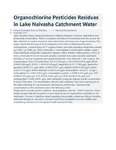| dc.description.abstract | Lake Naivasha, Kenya, hangs precariously in balance between economic exploitation and
biodiversity conservation. There is increasing intensity of horticultural activities around the
lake, believed to result in excessive water abstraction and heavy use of agrochemicals. This
paper reports the findings of an investigation conducted to determine the extent
environmental contamination of 17 organochlorine pesticides including metabolites namely
p,p’-DDT, p,p’-DDE, p,p’-DDD, endosulfan I, endosulphan II, endosulphan sulfate, endrin,
endrin aldehyde, heptachlor, heptachlor epoxide, aldrin, dieldrin, methoxychlor, α-HCH, β-
HCH, γ-HCH and δ-HCH in 36 water samples collected from Lake Naivasha catchment.
Residues of varying magnitude and spatial distribution were detected in the samples. The
concentrations of α-HCH varied from 0.013-0.776 μg/l, γ-HCH (0.033-0.419 μg/l), βHCH
(0.004-0.059 μg/l), δ-HCH (<0.010-0.059 μg/l), heptachlor (0.571-7.000 μg/l), heptachlor
epoxide (0.0050.177 μg/l), aldrin (0.0050-0.597 μg/l), dieldrin (0.004-0.765 μg/l), endrin
(0.005-0.195 μg/l), endrin aldehyde (0.020-0.256 μg/l) endosulphan I (0.020-0.124 μg/l),
endosulphan II (<0.002-0.267 μg/l), endosulphan sulphate (<0.008-0.735 μg/l), p,p’-DDT
(0.006-0.197 μg/l), p,p’-DDE (0.030-0.588 μg/l), p,p’-DDD (0.018-0.050 μg/l) and
methoxychlor (<0.002-0.891 μg/l), with heptachlor giving the highest overall concentration
in most of the sites. The concentration showed wide variations from one sampling site to
the other reflecting the socioeconomic diversity around the lake. Total pesticide
concentrations in the catchment was in the following order
Σheptachlors>Σmethoxychlor>Σaldrins> Σendosulphans>ΣHCHs >ΣDDTs>Σendrins. These
results suggest that the occurrence is as a result of use of organoclorine pesticides in the
catchment. Concern is therefore raised regarding the possible deleterious effects including
endocrine disruption not only in livestock and human population but also wildlife, thus
constituting a threat to the ecosystem health around the lake. | en_US |

